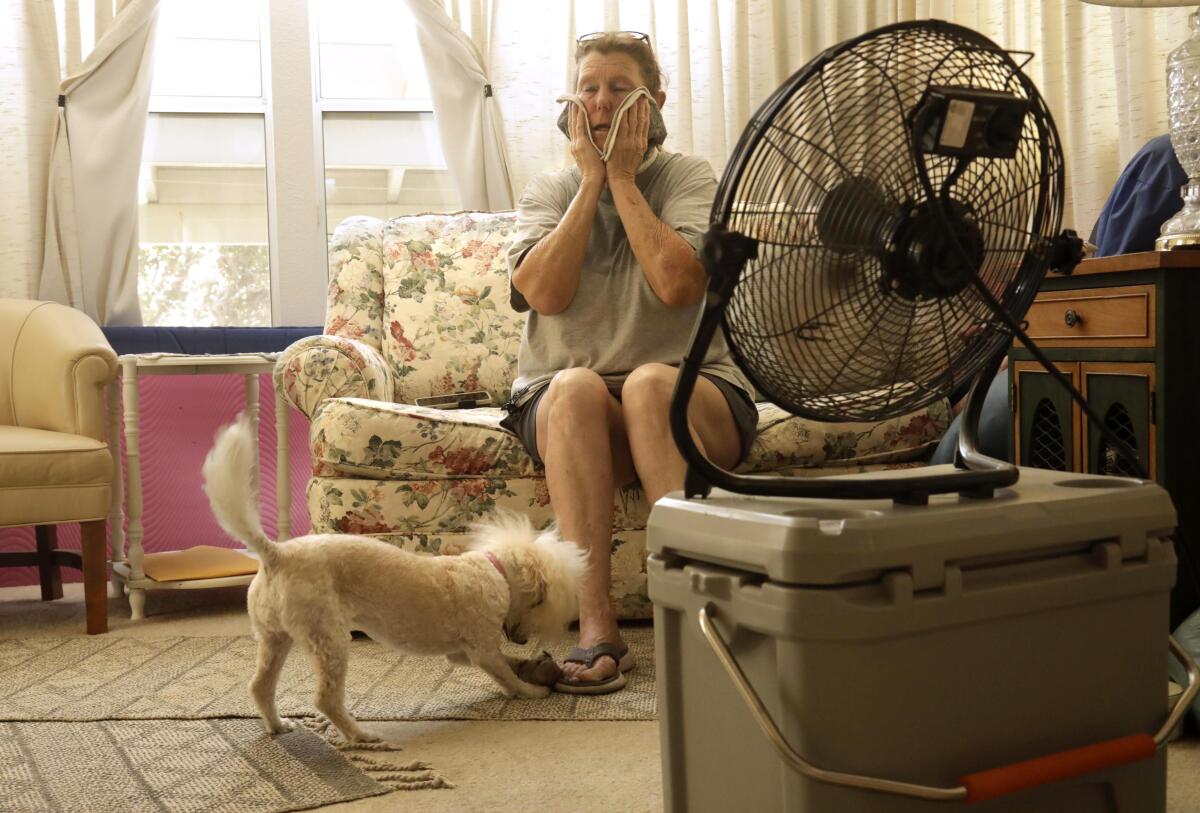Editorial: Heat waves are killing Californians in their homes. Cooling standards could save lives

- Share via
In the summer it can get up to 120 degrees inside the un-air-conditioned home Agustin Pedro Pedro rents in the San Joaquin Valley city of Madera, so unbearably hot that he sweats, feels faint and gets headaches.
“I arrive tired from work, but I can’t even rest in my own home because the heat doesn’t allow me,” the 60-year-old farmworker told state lawmakers at a recent hearing in Sacramento. He has asked his landlord to install something to cool the rental unit, but he refuses.
“We don’t deserve to live like this,” Pedro said.
But there is nothing forcing his landlord to do anything. Although state law and building codes require residential units to have heating to maintain temperatures of 70 degrees inside during cold weather, there is no requirement for air conditioning or any other cooling mechanisms to keep residents safe from extreme heat.
That is no longer acceptable in a world where rising temperatures from climate change are fueling more frequent and severe heat waves. And it’s one of many examples of how California is failing to protect people from the deadliest impact of climate change.
But a bill in the state Legislature would require residential units to maintain adequate cooling and make lack of cooling a substandard condition for human habitation of rentals. It would bring the greatest benefits to renters by allowing them to file code enforcement complaints if their landlord fails to provide cooling. It’s one of several bills that have been introduced in recent months in an effort to jump-start California’s anemic response to extreme heat.
The legislation, Assembly Bill 2597 by Assemblyman Richard Bloom (D-Santa Monica), has sparked opposition from the rental housing industry and other building and real estate interests who would be on the hook for providing cooling. But contrary to some of their claims, the legislation would not mandate air conditioners in every housing unit. Rather, it directs officials to craft statewide standards for safe indoor temperatures, which could include air conditioning or energy-efficient heat pumps where necessary, but could also be achieved through improved insulation, solar reflective cool roofs, ventilation, shade trees and other measures, depending on the local climate and specific site conditions.
This is a sensible approach that leaves the details, such as what the maximum indoor temperature would be, to regulators who are best equipped to set standards that protect residents’ health and safety without placing undue burdens on builders and property owners.
California would not be breaking entirely new ground, either. Dallas and Tempe and Tucson in Arizona are among the U.S. cities that already require air conditioning or other cooling equipment in rental units, according to the International Code Council, an association that develops building standards and conducted an examination of the 25 hottest cities in the U.S. at the request of a Times editorial writer. Those cities’ standards vary but generally require property owners to be able to keep indoor temperatures from exceeding 82 to 88 degrees.
A Times investigation last year found that California, despite its reputation as a climate leader, chronically undercounts the number of people who die from extreme heat and has failed to address the growing threat of heat-related illness and death. State records attributed 599 deaths to heat exposure between 2010 and 2019, but a Times analysis found that the true death toll is probably six times higher.
Enshrining temperature standards for residential units in state law is critical for protecting Californians whose neighborhoods and housing magnify their risks from extreme heat yet have few resources to stay safe. But the state needs to attack this problem from multiple angles, which is why it is important for lawmakers to advance other heat-related legislation too.
One bill would make California the first state in the nation to establish a ranking and early warning system for heat waves. Another, Assembly Bill 2076, would require the appointment of a chief heat officer to coordinate a statewide program to respond to extreme heat and oversee the implementation of a system to track deaths and hospitalizations from extreme heat in near real time, addressing a key government shortcoming Times reporters identified last year.
Other proposed legislation would strengthen workplace safety standards to prevent heat illness among outdoor workers, invest in tree-planting and other greening projects to reduce the urban island effect, develop recommendations to keep pregnant people and infants safe from extreme heat and create an advisory committee to study the effects of extreme heat on California’s workers, businesses and economy.
Gov. Gavin Newsom earlier this year released a new extreme heat plan and in his budget has proposed nearly $1 billion to retrofit older buildings with new appliances like electric heat pumps — which both cool and heat homes without fossil fuels — as well as insulation and other improvements to better withstand extreme heat, with much of the funding aimed at low-income residents. But state lawmakers are right to advance extreme heat legislation with more specific metrics and timelines, and of course, the force of law behind them.
California can lead on climate change again and it can start with common-sense steps to protect people from overheating inside their own homes.
More to Read
A cure for the common opinion
Get thought-provoking perspectives with our weekly newsletter.
You may occasionally receive promotional content from the Los Angeles Times.










